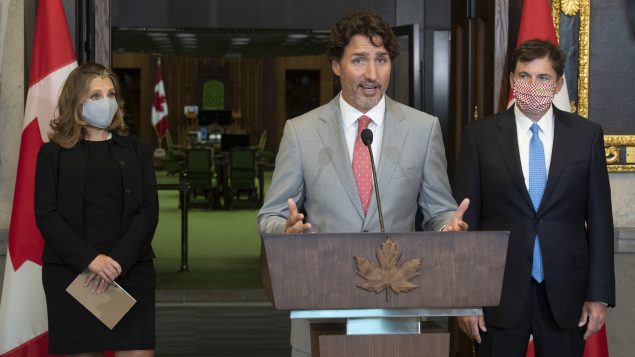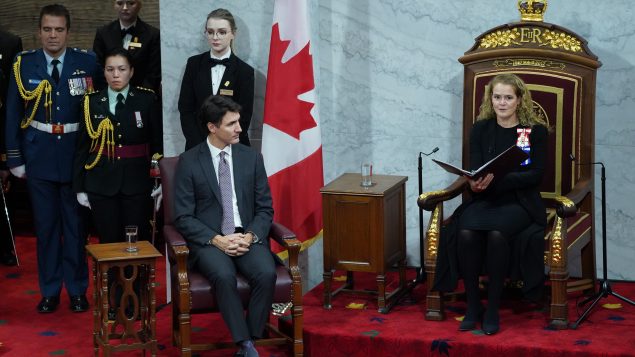Prime Minister Justin Trudeau sought and received Gov. Gen. Julie Payette’s consent on Tuesday to prorogue Parliament until Sept. 23.
Trudeau said the move is a way to address a long-term plan to recover from COVID-19.
But prorogation also puts a temporary end to the four committees that have spent the summer probing how WE Charity, a non-governmental organization with close connections to Trudeau’s family, was chosen to administer a multimillion-dollar program to encourage students to volunteer in pandemic-related community service.
The controversy over the now-abandoned program has spawned investigations by the federal ethics and conflict of interest watchdog into Trudeau and his former finance minister, Bill Morneau, who also has close family ties to WE Charity.

Standing in front of the House of Commons chamber Deputy Prime Minister and Minister of Finance Chrystia Freeland and President of the Queen’s Privy Council for Canada and Minister of Intergovernmental Affairs Dominic LeBlanc look on as Prime Minister Justin Trudeau speaks during a news conference on parliament hill in Ottawa, Tuesday, Aug. 18, 2020. (Adrian Wyld/THE CANADIAN PRESS)
This is also the first prorogation of Parliament for Trudeau, who’s been accused by the opposition of hypocrisy and breaking his own 2015 promise not to use prorogation to evade political responsibility.
Outgoing Conservative Leader Andrew Scheer called Trudeau “spineless” and accused him of “hiding out” amid a political controversy.
“At a time when Canadians are looking for stability and leadership, Justin Trudeau has given them corruption, chaos, and cover-ups,” Scheer said, calling Trudeau’s use of prorogation “a disgusting attempt to make Canadians forget about his corruption.”
Trudeau defended his decision Tuesday, saying the move “is about testing the confidence of the House.” He also described the country as “at a crossroads.”
“As much as this pandemic is an unexpected challenge, it is also an unprecedented opportunity,” Trudeau said. “And this is our chance to build a more resilient Canada, a Canada that is healthier and safer, greener and more competitive, a Canada that is more welcoming and more fair. This is our moment to change the future for the better.”
Here’s what prorogation means, how it’s been used in the past and what comes next.
What is prorogation?
The word prorogation comes from a Latin root, prorogare, which means to prolong.
Prorogation formally ends a session of Parliament, allowing for a new beginning with a Speech from the Throne.
Prorogation was developed as a political tool to be used by monarchs and prime ministers during the Tudor period in English history, in the late 15th early 17th century, as a more economical alternative to dissolving the Parliament. Unlike prorogation, dissolution formally ends not only the current parliamentary session but the Parliament itself and triggers a general election.
Normally, a prime minister can request prorogation – usually no longer than ten weeks – after achieving all of the legislative goals set out in the Speech from the Throne.
Prorogation basically acts as a reset button for the work of the Parliament.
What happens when Parliament is prorogued?
The prorogation of a parliamentary session effectively clears the Order Paper of parliamentary business.
Once prorogation is announced, all Members of Parliament are released from their parliamentary duties until Parliament is next summoned. Any existing bills and ongoing committee work — including studies and investigations — are halted, and can be introduced as entirely new.
Committees stop sitting after prorogation, but committee work may be revived later, either by the House or in committee.
MPs can reinstate bills and revive committee work to their previous stages before prorogation if certain conditions are met, such as unanimous consent by the House of Commons.
What happens when Parliament returns?
Following the intercession, the Parliament reconvenes for a new session, which the government opens with a new Speech from the Throne.
This outlines the government’s legislative priorities for the upcoming session and the subsequent vote in the House of Commons on the government’s agenda constitutes the first vote of confidence. If the government gets the majority of votes (i.e. retains the confidence of the House), no general election occurs and the government remains intact.
However, if the government loses the vote of confidence – a distinct possibility for the minority Liberal government – then a new election is called.
What is a Speech from the Throne?

Prime Minister Justin Trudeau listens as Governor General Julie Payette delivers the Throne Speech in the Senate chamber in Ottawa, Thursday, Dec. 5, 2019. (Chris Wattie/THE CANADIAN PRESS)
Every new session of Parliament is opened with a reading of the Speech from the Throne, which introduces the government’s directions and goals. Until the speech is read — traditionally by the Governor General — the House of Commons and the Senate cannot conduct any public business.
It is called Speech from the Throne because it is delivered by the Governor General, the Queen’s representative in Canada, from the throne of the Senate chamber.
Members of the House of Commons, senators and justices of the Supreme Court of Canada are all invited to attend the reading.
With files from CBC News and The Canadian Press







For reasons beyond our control, and for an undetermined period of time, our comment section is now closed. However, our social networks remain open to your contributions.